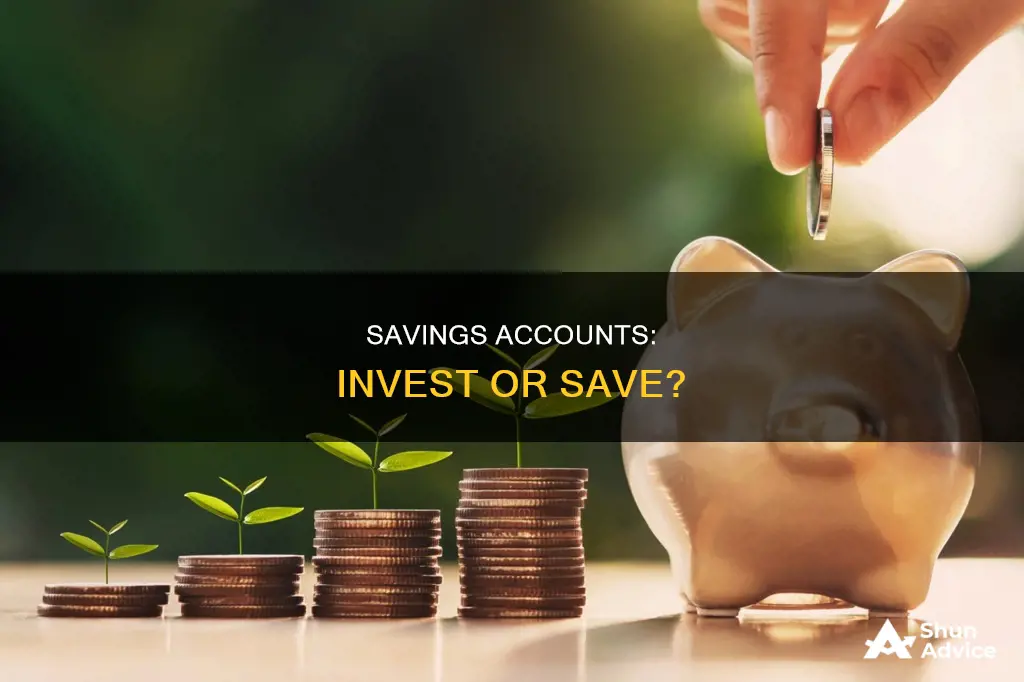
Saving and investing are both important concepts for building a sound financial future, but they are not the same thing. Saving typically results in lower returns but with virtually no risk, while investing allows for higher returns but with the risk of loss. Saving is best for immediate or near-term expenses, while investing is better for long-term goals.
| Characteristics | Values |
|---|---|
| Risk | Saving is low-risk, investing is higher-risk |
| Returns | Saving offers lower returns, investing offers higher returns |
| Time horizon | Saving is for the short-term, investing is for the long-term |
| Goals | Saving is for emergencies, investing is for retirement |
| Access | Saving offers immediate access, investing has barriers to access |
| Liquidity | Saving is very liquid, investing is less liquid |
| Taxes | Savings accounts are taxed, investment accounts may be tax-deferred |
What You'll Learn

Emergency funds
How Much to Save
The recommended amount for an emergency fund is typically three to six months' worth of living expenses. However, this can vary depending on individual circumstances, including lifestyle, monthly costs, income, and dependents. It's a good idea to evaluate your specific situation and consider the most common types of unexpected expenses you might encounter. Even if you're living paycheck to paycheck, setting aside a small amount consistently can provide financial security and peace of mind.
Where to Keep Your Emergency Fund
It is best to place your emergency savings in an easily accessible, interest-bearing bank account, such as a money market account or an interest-bearing savings account. This ensures that you can quickly withdraw funds without incurring taxes or early withdrawal penalties. Avoid placing emergency funds in mutual funds, stocks, or other volatile assets that could lose value if accessed hastily.
When to Use Emergency Funds
The purpose of an emergency fund is to cover expenses directly related to unforeseen emergencies. It's important to set guidelines for what constitutes an emergency to maintain consistency. While not every unexpected expense is a critical emergency, you may need to use your fund for uncovered medical bills, car repairs, or home repairs, among other unforeseen costs.
Strategies for Building an Emergency Fund
- Create a Savings Habit: Set a specific goal for your emergency fund and make consistent contributions. Monitor your progress regularly and celebrate your successes.
- Manage Your Cash Flow: Keep track of your income and expenses to identify opportunities to adjust your spending and savings. Work with your creditors to adjust due dates for bills and take advantage of weeks when you have extra money to boost your savings.
- Take Advantage of One-Time Opportunities: Save all or a portion of any large sums you receive, such as tax refunds, holiday gifts, or birthday money.
- Make Your Saving Automatic: Set up recurring transfers from your checking account to your savings account. This ensures consistent contributions and helps you save effortlessly.
- Save Through Work: If you receive a regular paycheck, consider dividing it between your checking and savings accounts through direct deposit.
In summary, establishing an emergency fund is a crucial step in achieving financial stability. By following these guidelines and strategies, you can ensure you have the necessary funds to navigate life's unexpected challenges.
Purchasing a Condominium: Saving or Investing?
You may want to see also

Short-term savings
High-Yield Savings Accounts
High-yield savings accounts are offered by banks or credit unions and provide a good alternative to holding cash in a checking account, which typically pays very little interest. These accounts are insured by the Federal Deposit Insurance Corporation (FDIC) at banks and by the National Credit Union Administration (NCUA) at credit unions, so your money is protected. While there is typically a limit of six fee-free withdrawals or transfers per statement cycle, you can still access your money quickly by transferring it to your primary bank or via an ATM. Online banks tend to offer higher interest rates than traditional brick-and-mortar banks.
Cash Management Accounts
Cash management accounts are offered by robo-advisors and online investment firms. They allow you to put your money into various short-term investments and often invest in low-yield money market funds. These accounts provide liquidity, and you may be able to write checks, transfer money, and perform other typical banking activities. The money can be withdrawn at any time, making it even more accessible than traditional savings and money market accounts, which restrict monthly withdrawals.
Money Market Accounts
Money market accounts are a type of bank deposit that usually offers a higher interest rate than regular savings accounts but requires a higher minimum investment. They are FDIC-insured, so your money is protected up to $250,000 per depositor, per bank. Money market accounts provide liquidity, although federal laws impose some restrictions on withdrawals.
Short-Term Bond Funds
Bond funds, such as short-term corporate or government bond funds, are good for investors who want a diversified portfolio without analyzing individual bonds. They are also suitable for those who don't have enough money to buy individual bonds. While not insured by the government, bonds tend to be safe investments, especially if you buy a diverse collection. Short-term bond funds have low exposure to changing interest rates, so fluctuations in rates won't significantly affect the fund's price. You can buy bond funds through online brokers that offer ETF and mutual funds.
Certificates of Deposit (CDs)
CDs are time deposits where you agree to hold your money in the account for a specified period, ranging from a few weeks to several years. In exchange, the bank offers a higher interest rate. No-penalty CDs allow you to withdraw your money without a fee, which is advantageous during rising interest rates. CDs are FDIC-insured, so your money is protected. However, one risk is missing out on better rates elsewhere while your funds are tied up.
Savings and Investment: Interplay in a Closed Economy
You may want to see also

Long-term investments
Types of Long-Term Investments
- High-yield savings accounts: These accounts offer higher-than-average interest rates, but they may require higher initial deposits and have limited withdrawals. They are usually FDIC-insured and provide a higher annual percentage yield than standard savings accounts.
- Certificates of deposit (CDs): CDs are FDIC-insured and offer a higher interest rate than regular savings accounts. However, they require locking your money in for a minimum period, and early withdrawals often incur a penalty. The interest rate is typically higher for longer periods.
- Education savings accounts: These accounts are specifically designed for saving for children's education. They allow tax-free contributions and withdrawals when higher education commences. They usually offer high-interest rates and have restricted withdrawals.
- Retirement accounts: Retirement accounts, such as 401(k) and IRA, are excellent examples of long-term savings vehicles. They help you save for retirement and benefit from compound interest. Contributions may also come with tax benefits, and some employers may even match your contributions.
Benefits of Long-Term Investments
- Higher interest rates: Long-term savings accounts generally provide higher interest rates due to the longer savings period.
- Compounding interest: The interest earned in long-term savings accounts is reinvested, and the base amount for calculating interest increases over time. This results in faster money multiplication and higher returns.
- Wealth-building: Keeping your money in a long-term savings account for an extended period allows your wealth to grow, especially with compound interest.
- Financial security: Long-term investments provide a sense of financial security, knowing that you have a set amount of money for future needs, such as retirement or one-time expenses.
- Setting goals: Long-term savings accounts help you set and achieve financial goals, such as saving for a mortgage or retirement.
- Tax benefits: Some long-term savings accounts offer tax advantages, such as tax-free withdrawals or tax-deferred growth.
Factors to Consider
When choosing a long-term savings account, consider the following factors:
- Interest rate: Compare the interest rates offered by different financial institutions to find the most competitive option. Longer lock-in periods usually result in higher interest rates. Ensure the interest rate is sufficient to beat inflation over the long term.
- Diversification: Diversifying your investment portfolio can help reduce risks and increase returns. Choose a long-term savings account with a variety of investment options.
- Fees and restrictions: Some long-term savings accounts may have fees, such as annual management fees or early withdrawal penalties. Consider the fees and restrictions associated with the account and how they align with your financial goals.
Savings and Investments: Smart Money Strategies for Beginners
You may want to see also

Risk tolerance
Those with a higher risk tolerance are known as aggressive investors. These investors are willing to risk losing money to get potentially better results. They tend to be market-savvy and understand the volatility of securities, following strategies for achieving higher-than-average returns. Their investments usually emphasise capital appreciation rather than income preservation. Aggressive investors often invest in stocks, equity funds, and exchange-traded funds (ETFs).
On the other hand, conservative investors have a lower risk tolerance and seek investments with guaranteed returns. They are typically closer to retirement age and are unwilling to risk losing their principal investment. Conservative investors often opt for lower-risk investments such as bank certificates of deposit (CDs), money markets, or US Treasuries.
When deciding whether to invest or save, it's important to consider your own risk tolerance. If you have a high-risk tolerance and are comfortable with potential losses, investing in the stock market may be a suitable option. However, if you prefer guaranteed returns and lower volatility, saving in a high-yield savings account might be a better choice.
It's worth noting that savings accounts offer minimal risk, as your money will always be there. Additionally, they provide easy access to cash when needed. However, they often offer lower returns compared to investment accounts, and the purchasing power of your cash may decrease over time due to inflation.
In contrast, investing in the stock market comes with higher risk, as your money can increase or decrease depending on market changes. However, it offers the potential for higher returns over the long term. Therefore, investing is generally more suitable for long-term goals, such as retirement planning, while savings accounts are typically used for shorter-term goals.
Unlocking Your Savings: Reading Investment Statements
You may want to see also

Financial goals
Setting financial goals is an important step towards achieving financial security. These goals can be short-term, mid-term, or long-term, and they provide a sense of direction and help you stay motivated. Here are some tips to help you establish and work towards your financial goals:
Identify and Prioritize Your Goals
Start by identifying what you want to achieve financially. This could include saving for retirement, building an emergency fund, saving for a down payment on a house, or investing in your child's education. Prioritize these goals based on their importance and urgency.
Set a Dollar Amount and Timeframe
Determine how much money you need to achieve each goal and set a realistic timeframe. For example, you might want to save $20,000 for a down payment on a house in the next three years.
Short-Term Goals
Short-term financial goals are those that can be achieved in a year or less. This may include creating a budget and sticking to it, building an emergency fund, or paying off credit card debt. For short-term goals, focus on building your savings and keeping your money easily accessible. High-yield savings accounts, money market accounts, and short-term certificates of deposit (CDs) are suitable options.
Medium-Term Goals
Medium-term goals typically take a few years to achieve, such as saving for a down payment on a house, pursuing higher education, or starting a family. For these goals, you'll want to maintain some liquidity and may consider setting up savings buckets within a single account or laddering CDs. Suitable accounts include high-yield savings accounts, money market accounts, and certificates of deposit.
Long-Term Goals
Long-term goals usually take five years or more to achieve, with retirement being the most common one. For long-term goals, consider using employer-sponsored retirement accounts, traditional or Roth IRAs, and high-yield savings accounts.
Automate Your Savings
To stay on track, consider automating your savings by setting up direct deposits or recurring transfers from your checking account into designated savings accounts for each goal.
Manage Risk
Investing always carries some level of risk, and it's important to understand your risk tolerance. Generally, the longer your investment horizon, the more risk you can take, as you have more time to recover from potential losses.
Work with a Financial Advisor
If you need help setting and achieving your financial goals, consider working with a financial advisor or planner. They can provide guidance and ensure you're making informed decisions about your savings and investments.
Condo Conundrum: Save or Invest?
You may want to see also
Frequently asked questions
Saving is a great way to build an emergency fund and meet short-term financial goals. It's also a safe option as there is a low risk of losing money. However, the returns are often low and you may miss out on the higher returns that come with investing.
Investing is a way to grow your money over time and reach long-term financial goals. It has the potential for higher returns than saving but always comes with the risk of losing money. It also requires discipline and a long-term perspective.
If you have short-term goals, saving is generally a good idea. If you are building an emergency fund, paying off debt or don't have a lot of money to invest, saving is recommended. If you have long-term goals and are comfortable taking risks, investing is a good option.







